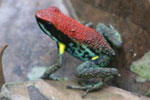
Black caiman (Melanosuchus niger) with fly near its eye in an ox-bow lake in Yasuni National Park. Photo by: Jeremy Hance.
The Yasuni-ITT Initiative has been called many things: controversial, ecological blackmail, revolutionary, pioneering, and the best chance to keep oil companies out of Ecuador’s Yasuni National Park. But now, after a number of ups and downs, the program is beginning to make good: the Yasuni-ITT Initiative has raised $300 million, according to the Guardian, or 8 percent of the total amount needed to fully fund the idea.
The program, which is the first of its kind, proposes to leave an estimated 850 million barrels of oil untouched in Yasuni National Park if donors worldwide compensate Ecuador for about half of the worth of the oil: $3.6 billion. The money would keep oil companies out of 200,000 hectares known as the Ishpingo-Tambococha-Tiputinin (ITT) blocs. The money doesn’t go directly to the Ecuador government, but instead to a United Nations Development Fund (UNDF) which will be used to fund green energy projects, conservation initiatives, reforestation programs, and community development. The involvement of the UNDF also adds extra assurances that if the funds are raised, the oil will stay in the ground.
While the $300 million raised is not yet near the full amount requested, it shows significant progress from a year ago when many predicted the Yasuni-ITT Initiative would suffer a quick demise. Ecuador has said it will give the program 13 years for full funding.
Proponents of the Yasuni-ITT Initiative argue that it will preserve one of the most biodiverse places on Earth, keep an estimated 410 million tons of CO2 out of the atmosphere, and protect indigenous people in the reserve. With one sweep, the initiative could help mitigate several of the world’s ecological crisis: mass extinction, deforestation, and climate change. However, critics argue that the program is little more than blackmail from Ecuador: as a National Park oil drilling should not be occurring in Yasuni in the first place. Still, Ecuador is not alone in seeking to exploit its national parks. More and more countries worldwide are opening protected areas to fossil fuel extraction as well as mining, logging, and plantations.
If successful, the Yasuni-ITT Initiative could have a major impact on how nations combat both climate change and biodiversity loss in the future. For example, the International Energy Agency (IEA) recently warned that if the world is to avoid dangerous climate change, two thirds of the world’s fossil fuels must be left in the ground. While it appears far-fetched today, paying nations not to exploit fossil fuel deposits could become common course as the impacts of climate change begin to rise.
Yasuni National Park is on the short-list of regions that may be the most biodiverse on the planet. Last year, researchers declared that Yasuni was the most biodiverse place in the western hemisphere at least based on data of birds, mammals, amphibians, and plant. A single hectare of rainforest in Yasuni has been found to hold more tree species—655—than all of the U.S. and Canada combined.
The Yasuni-ITT Initiative has a broad array of supporters, including UN head Ban Ki-moon, author and ecologist Michael Tobias, and actors Leonardo DiCaprio and Edward Norton, who is also the UN Goodwill Ambassador for Biodiversity.

Morpho butterfly in Yasuni National Park. Photo by: Jeremy Hance.

Close-up of wild female Brazilian tapir (Tapirus terrestris), which was raised by an indigenous tribe after her mother was hunted for food, periodically seeks out humans. Photo by: Jeremy Hance.

Rufescent tiger heron (Tigrisoma lineatum) in Yasuni National Park in the Ecuadorian Amazon. Photo by: Jeremy Hance.

Guide picking up a bom jardim toad (Rhinella dapsilis) with a leaf in Yasuni National Park. Photo by: Jeremy Hance.

Aerial view of Yasuni National Park. Notice tree in center with yellow blooms. Photo by: Jeremy Hance.
Related articles
New forest map shows 6% of Amazon deforested between 2000 and 2010

(09/21/2012) An update to one of the most comprehensive maps of the Amazon basin shows that forest cover across the world’s largest rainforest declined by about six percent between 2000 and 2010. But the map also reveals hopeful signs that recognition of protected areas and native lands across the eight countries and one department that make up the Amazon is improving, with conservation and indigenous territories now covering nearly half of its land mass.
Human rights court favors indigenous tribe over Ecuadorian government in oil battle
(07/31/2012) The Inter-American Court of Human Rights has found in favor of a Kichwa community’s right to consultation prior to industrial projects on their land in a ruling that could have implications for many indigenous peoples across the Americas. The court found that the government of Ecuador violated the indigenous people’s rights by allowing the Argentine oil company, Compania General de Combustibles (CGC), on their land without proper consultation.
Want to stop climate change: buy fossil fuel deposits
(06/07/2012) Governments, NGOs, and others fighting climate change should consider buying coal and oil deposits—not to exploit them, but to keep them from being exploited, according to a bold new policy paper in the Journal of Political Economy. Economist Bard Harstad with the Kellogg School of Management argues that climate coalitions could quickly slash carbon emissions by purchasing and conserving marginal fossil fuel deposits, a strategy that would solve the current problem of carbon leakage, i.e. when cutting emissions in one place pushes others to burn more elsewhere. Given that carbon emissions rose to a new record last year—31.6 gigatons—and carbon has hit 400 parts per million (ppm) in the atmosphere for the first time in at least 800,000 years, Harstad’s analysis comes at a time when scientists are warning that urgent and bold action is needed to mitigate global climate change before it becomes irreversible.
Pictures of Yasuni, Ecuador’s rainforest gem

(04/27/2012) In late 2010, mongabay.com reporter Jeremy Hance traveled to Yasuni National Park, arguably the most biodiverse place on the planet and home to a unique initiative to save a rainforest by asking the international community to pay to keep oil in the ground. Researchers have found more tree species in a single hectare in Yasuni National Park than in all of the U.S. and Canada combined. Yasuni also contains the highest biodiversity of reptiles and amphibians in the world with 271 species. But insects trump them all: entomologist Terry Erwin has estimated that a single hectare of rainforest in Yasuni may contain as many as 100,000 unique insect species.
Ecuador makes $116 million to not drill for oil in Amazon

(01/02/2012) A possibly ground-breaking idea has been kept on life support after Ecuador revealed its Yasuni-ITT Initiative had raked in $116 million before the end of the year, breaking the $100 million mark that Ecuador said it needed to keep the program alive. Ecuador is proposing to not drill for an estimated 850 million barrels of oil in the Ishpingo-Tambococha-Tiputinin (ITT) blocs of Yasuni National Park if the international community pledges $3.6 billion to a United Nations Development Fund (UNDF), or about half of what the oil is currently worth. The Yasuni-ITT Initiative would preserve arguably the most biodiverse region on Earth from oil exploitation, safeguard indigenous populations, and keep an estimated 410 million tons of CO2 out of the atmosphere. However, the initiative is not without its detractors, some arguing the program is little more than blackmail; meanwhile proponents say it could prove an effective way to combat climate change, deforestation, and mass extinction.
Yasuni ITT: the virtues and vices of environmental innovation
(12/07/2011) As the 17th Conference of the Parties to the United Nations Framework Convention on Climate Change (UNFCCC) is taking place in Durban, Ecuador has embarked on the development of a project presented as highly innovative. This project targets Yasuni National Park, which has been protected since 1979. Yasuni is home to several indigenous peoples and is a biodiversity hotspot. But it so happens that the park also sits atop a vast oil field of 846 million barrels, representing about 20 percent of the country’s oil reserves. The acronym Yasuni ITT stands for Ishpingo-Tambococha-Tiputinin, which are the names of three potential zones for oil extraction.
New map reveals the most biodiverse place on Earth, but already threatened by oil

(09/22/2011) A new map highlights the importance of conserving Yasuni National Park as the most biodiverse ecosystem in the Western Hemisphere, and maybe even on Earth. Scientists released the map to coincide with the United National General Assembly in support of a first-of-its-kind initiative to save the park from oil exploration through international donations to offset revenue loss. Known as the Yasuni-ITT Initiative, the plan, if successful, would protect a 200,000 hectare bloc in Yasuni National Park from oil drilling in return for a trust fund of over $3 billion.
Germany backs out of Yasuni deal

(06/13/2011) Germany has backed out of a pledge to commit $50 million a year to Ecuador’s Yasuni ITT Initiative, reports Science Insider. The move by Germany potentially upsets an innovative program hailed by environmentalists and scientists alike. This one-of-a-kind initiative would protect a 200,000 hectare bloc in Yasuni National Park from oil drilling in return for a trust fund of $3.6 billion, or about half the market value of the nearly billion barrels of oil lying underneath the area. The plan is meant to mitigate climate change, protect biodiversity, and safeguard the rights of indigenous people.
Uncovering the private lives of Amazon wildlife through camera traps

(05/20/2011) One of the best words to describe Amazon wildlife, including large mammals and birds, is cryptic. A person can spend a day trekking through the dense green and brown foliage of the Amazon and see nothing more than a few insects, maybe a frog here and there if they have good eyes. In fact, researchers have spent years in the jungle and never seen a jaguar, let alone a tapir. Some species like the bushdog and the giant armadillo are even more cryptic. Almost never encountered by people, in some parts of the Amazon they have taken on a mythic status, more rumor around the fire than reality. However, camera traps—automated cameras that take a flash photo whenever an animal triggers an infrared sensor—in the Amazon have begun to reveal long-sought information about the presence and abundance of species, providing new data on range and territories. And even at times giving glimpses into the private lives of species that remain largely shrouded in mystery.